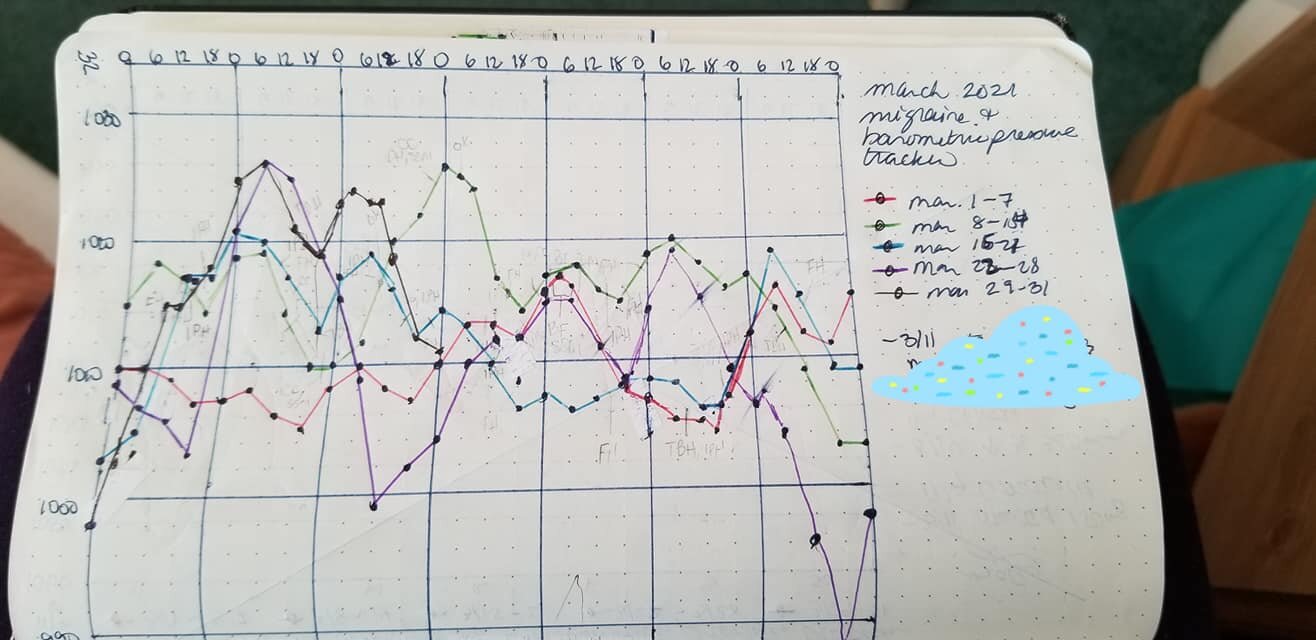I think it was around 2018* that I started to suffer from migraines, or at least, they started to become an issue. Although at the time, I complained to my doctor about “really bad weather-related sinus headaches.”
Since the headaches start when the barometric pressure rises, my doctor didn’t jump right away to call it a migraine. Since hypertension runs in my family, I was diagnosed with that and started taking blood pressure medication.
Fast forward to 2019. My GP wasn’t available so I wound up with another doctor at the clinic. I complained that the weather-related headaches were getting worse and he recommended that I start keeping a headache log. He was my attending doctor for the next few visits, so I gave him updates while he gave me suggestions. He urged me to continue logging my triggers and remedies.
It was really just this year that we started looking at my headaches as migraines. One glance at the Timeline of a Migraine Attack (Source: American Migraine Foundation) confirmed that I have been suffering from something beyond a mere sinus headache:
I do have my own nicknames for my most common symptoms, such as “Thinking is Hard,” “Words Hard", “Icepick Head,” “Super Senses,” “Sinus Head,” “Foggy Brain,” “Super Slow Mode,” etc.
Here is a good talk about migraines featuring Dr. Michael Teixido, a neurotologist from Delaware and Vice President of the Association of Migraine Disorders. He describes how the brain and body react to a migraine trigger, understanding your pattern, and learning to manage your triggers:
March was my breakthrough month. I started to chart my symptoms in relation to the barometric pressure changes:


I learned that I’m in Group 1 - those who suffer before the weather changes (e.g. chinook, thunderstorm). Most people I know belong to Group 2 - those who suffer when the change hits (Source: CBC: Migraines and asthma flare-ups may be due to weather changes, says doctor).
But knowing the pattern wasn’t enough. I wanted to be able to predict when I might have a migraine so that I could schedule my heavy thinking tasks when I wasn’t in the middle of “Completely Useless Mode.” I vlogged about working with the barometric pressure forecast:
Around this time, I stumbled upon migraine hats. I wound up buying three different kinds: the Icekap, Tolaccea Migraine & Headache Hat and FOMI Gel Ice Hat. Check out my unboxing and review videos below:
They all provide cold therapy and compression therapy - two things migraineurs crave during the neurological roller coaster of pain and weirdness known as a migraine.
Thanks to understanding my pattern and the weather forecast, with planning I can usually get through migraine attacks armed with my migraine hats, and mitigating my symptoms and triggers within my control. I can generally predict when I might need a Migraine Nap and/or Tylenol.
But still, that wasn’t enough. I wanted to learn how to decrease the severity and frequency of my migraine attacks. However, I wanted to do this without taking prescription medication, botox, e-TNS or surgery.
Enter my “gauntlet of migraine management” - vitamins and supplements. Migraineurs tend to be low on Riboflavin (Vitamin B2), Magnesium, CoQ10, Vitamin D, and Melatonin. Click here for the recommended dosages.
I added the vitamins one at a time, so I can share how each improved my situation:
Vitamin D: Increasing my dosage through vitamins and sunshine just meant that my immune system got a huge boost.
Magnesium: Decreased the severity of the headache symptoms within one to two weeks of adding it.
Melatonin: Better sleep.
CoQ10: Decreased the severity of the “brain fog” symptoms.
Vitamin B2: Decreased the frequency and severity to the point I am barely affected by the weather changes when my fellow Group 1 friends are riding the roller coaster of pain.
Although there are migraine multivitamins out on the market, I prefer to take the vitamins individually. That way, if I eat more foods rich in Magnesium and Melatonin, I don’t need to take as much in pill form that day. Don’t bother trying to eat the required CoQ10 intake for migraineurs It’s just not feasible to eat 51 pounds of salmon a day.
It’s a work in progress. I have since discovered I have additional migraine triggers, which are manageable if I am vigilant. Although I’m doing much better these days, I still need to make sure I don’t overwhelm my sensitive little brain by letting the triggers pile up. Been there, done that. Don’t care to repeat.
If you would like to learn more about how barometric pressure affects your health or about managing your migraines, check out these links:
Migraine Canada (check out the “Resources” page)
Do you suffer from migraines or other weather-related chronic conditions? Share any tips, tricks or comments below.
*December 8, 2021 note: It must have been longer than 2018 as I recall that Maestro would guard me whenever I was lying down on the floor with a severe bout, and he passed away in 2016.


